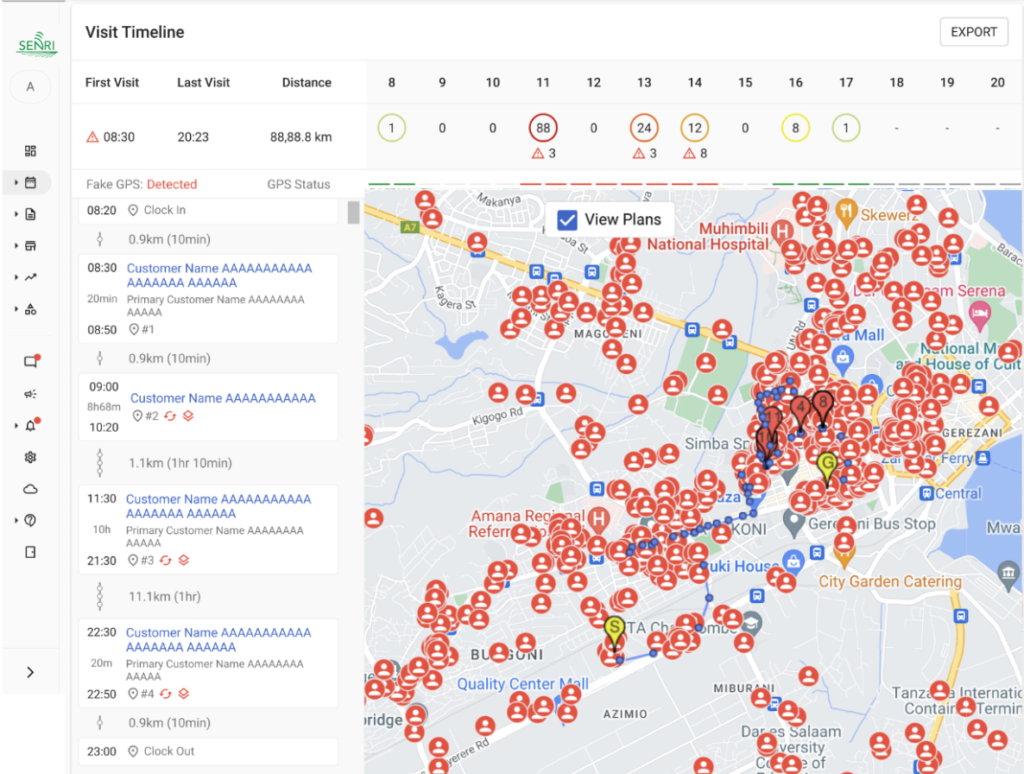Have you ever wondered what Salesforce automation (SFA) actually automates? Simply digitising tasks is not enough to claim true automation.
At SENRI, we understand this and provide a variety of features to automate tasks required for sales management and increase efficiency. Additionally, we make activity and sales analysis possible, which are difficult to achieve manually.
GPS tracking and verification
Let’s take a look at our GPS tracking and verification function, which is a fundamental feature. SENRI automatically acquires and calculates the following information using GPS:
- Sales staff’s location tracking
- Calculation of distance travelled
- Acquisition of customer location information and visit verification
- Calculation of stay time at customer location
This function allows you to confirm whether your sales staff are carrying out their sales activities efficiently. It can reveal situations where staff are falsely recording visits or completing most of their visits in the morning, leaving little activity for the afternoon.
Suspicious visit and standard duration of visit
Although you may be able to uncover many issues by carefully examining GPS tracking data every day, it may be difficult for managers to allocate such time on a continuous basis. This is where the suspicious visit function comes in handy. It can detect false or sloppy visits based on visit time and distance trends. Here are some examples of indicators:
- (Densed distance visits) Number of serial visit with 50m moving distance
- (Densed time visits) Number of visits within 30mins
- (Densed distance customers) Number of customers located within 5m square
- (Long visits) Number of visits with exceeding standard duration of visit
- (Short visits) Number of visits with lowering standard duration of visits
SENRI sets the ideal numerical values for the above indicators, but it is also possible to set your own values based on your company’s requirements. While using SFA, it is common to focus on increasing the number of visits and sales activities for sales staff who are not active enough. However, this function can also prevent false increases in visit and activity numbers.

Weekly Activity Red-flag
As the amount and duration of data increases, processing data manually becomes increasingly difficult. The previously mentioned functions are very useful for understanding snapshot information on a daily, weekly, monthly basis. Weekly Activity Red-flags analyses trends over the weeks or the months and automatically detects any deviations. For example:
- The number of short visits has increased by more than 20% compared to the previous week.
- The number of visits is deviating from the standard deviation of the past 20 weeks.
- The onsite rate is continuously below 80%.
Even if you are worried about not being able to monitor your sales staff closely enough after introducing SFA, this function is still recommended for you.
Automated reminders
This is a set of functions that automates or semi-automated communication with customers or sales staff, which is a slightly different type of function.
- Notify distributors or sales representatives by email or app notification when an order is placed by a secondary customer
- Notify the customer by SMS when the payment deadline has passed
- Notify the customer by SMS when the product is ready for delivery and the delivery date or time is confirmed
- Notify the sales staff of price changes or promotions at specified times
- Set targets for visit numbers or sales, so that sales staff can track their progress
These features enable smooth and efficient communication with customers and distributors who do not directly use SENRI.
ERP, Accounting system, LPO scraping, Tax registration integration and Open API
Finally, we introduce the integration function with 3rd party applications. Sales records, especially sales data, often need to be coordinated across various departments. When this happens, re-entering data or exchanging data using CSV can be time-consuming, laborious, and lead to errors. SENRI mainly solves this problem by using APIs.
- ERP and accounting system integration
Automated data coordination up to every 15 minutes is possible using the API module managed by SENRI. Since this API operates bidirectionally, it is possible to coordinate order data obtained from SENRI as well as overwrite payment information input into ERP with SENRI. - LPO scraping
Even if you use SENRI effectively, some customers may continue to send orders in other data formats such as PDF. In such cases, SENRI’s LPO scraping uses OCR technology to automatically convert data. - Tax registration integration
This service is only available in some countries, but by coordinating with a tax registration system or device certified by the government, especially when conducting van sales, tax declaration can be dramatically streamlined. - Open API
This service is provided for developers, but by using Open API, you can freely extract data from SENRI and coordinate it with your own database or other services that you use. However, this is limited to services that support API coordination. It is a service that responds to advanced needs such as wanting to analyse and store SENRI data together with all other data managed within the company.
If you have any questions or are interested in learning more about SENRI, please do not hesitate to contact us.